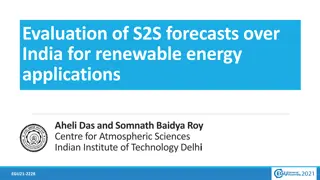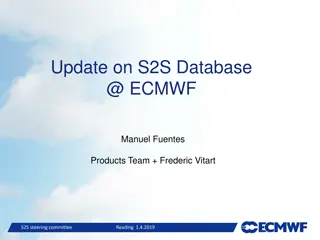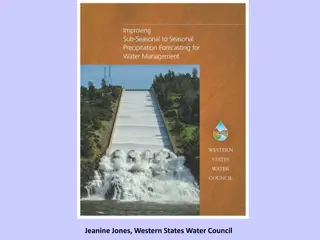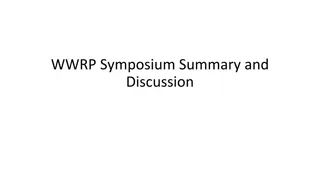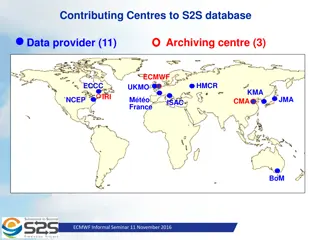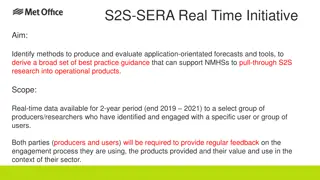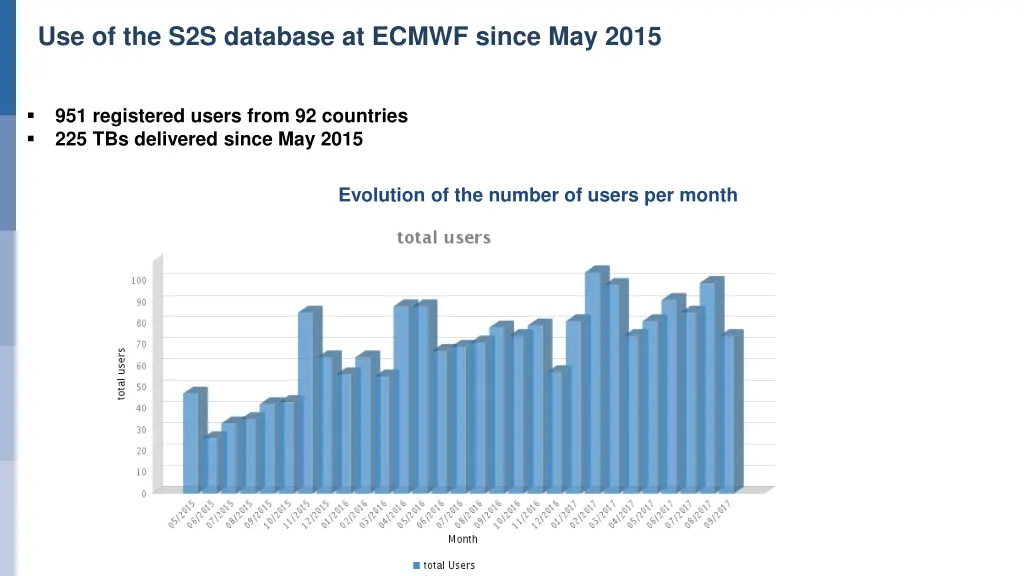
Evolution of ECMWF S2S Database and Model Changes Since 2015
Discover the evolution of the S2S database at ECMWF since May 2015, with insights on registered users, total volume delivered, user origins, and upcoming model changes. Stay informed about the changes to expect and the documentation updates, along with the availability of the RMMS database. Explore forecast graphical products and the enhancements planned for the future.
Uploaded on | 1 Views
Download Presentation

Please find below an Image/Link to download the presentation.
The content on the website is provided AS IS for your information and personal use only. It may not be sold, licensed, or shared on other websites without obtaining consent from the author. If you encounter any issues during the download, it is possible that the publisher has removed the file from their server.
You are allowed to download the files provided on this website for personal or commercial use, subject to the condition that they are used lawfully. All files are the property of their respective owners.
The content on the website is provided AS IS for your information and personal use only. It may not be sold, licensed, or shared on other websites without obtaining consent from the author.
E N D
Presentation Transcript
Use of the S2S database at ECMWF since May 2015 951 registered users from 92 countries 225 TBs delivered since May 2015 Evolution of the number of users per month
Use of the S2S database at ECMWF since May 2015 User s Country of origin
Model Changes since Dec 2016 ECMWF: Cycle 43R3 (July 2017) HMCR: Real-time forecasts on Thursdays 00Z (previously Wednesdays) since 8 June 2017 ISAC: Real-time forecasts on Thursdays (previously Mondays) since 19 January 201 JMA : New model (GEPS1701) since 22 March 2017. New set of fixed re-forecasts archived. UKMO: Number of re-forecasts has been extended from 3 to 7 (March 2017)
Model Changes to appear soon ISAC: 32-day forecasts instead of 31 days. Extended re-forecasts: 5 members instead of 1 member (in progress) + geopotential height provided at all pressure levels. ECCC: to provide soil temperature and soil moisture variables KMA: to provide fluxes
RMMS database Available from ftp://acquisition.ecmwf.int/ (login/passwd: s2sidx) Updated near real-time Some initial issues (data removed accidentally) have been fixed Verification from ERA Interim has been added Need for publication! Next steps: Add new indices: Tropical cyclone tracks (2018?) Weather regimes (?) SSWs (?) ..
Forecast graphical Products (updated 3 weeks behind real-time) 2 metre temperature/precip/geopotential height weekly mean anomalies MJO RMM index + OLR/U200/U850 hovmoeller diagrams Extreme Forecast index for 2-metre temperature Plots from 7 S2S models currently available.
Recent issues Data is not backed-up. Normally the other database archiving centre should be the back-up. Recently a tape has broke down: 9 TBs (about 25%) of re-forecast archive. Most of the fixed re-forecasts have been staged on disk, but not all (e.g. HMCR). Tape has been sent for repair (should take about 2 weeks) Extent of damage not known yet .
S2S database provider panel Need for a database panel, for the same reasons as the TIGGE Panel. In some instances the person responsible for data transfer is the same for TIGGE and S2S, so perhaps a single panel for both datasets would be appropriate? The aims for S2S and TIGGE portals are similar: a) Ensure continuity of data transfer and the engagement of the data providers. b) Ensure that WWRP has information on the use of the datasets and their impact on research by including the statement of use in paper acknowledgements, maintaining a record of publications and surveying users on their use of the data and any obstacles to using it.
New variables to be added Ocean/sea-ice variables: Sea surface salinity Depth of 20 deg isoth Mixed layer depth Heat content at top 300m Salinity in top 300m U surface current V surface current Sea surface height Sea ice thickness These new variables will be archived in netcdf in MARS. Work is ongoing to archive ocean data in the MARS system (project for ERA-CLIM2). New variables will not be ready for all the S2S models straight away. For models with fixed climatology, we may need to wait the next version of these model. Progress: a prototype for archiving netcdf S2S ocean data to be ready by March 2018. First data from ECMWF to be archived by end 2018. October 29, 2014
S2S publications (18 so far) Baggett, C.-F., Elizabeth A. Barnes, Eric D. Maloney, and Bryan D. Mundhenk, 2017: Advancing atmospheric river forecasts into subseasonal-to-seasonal time scales. Geophysical Research Letters 73. Bombardi RJ, Pegion KV, Kinter JL, Cash BA and Adams JM (2017): Sub-seasonal Predictability of the Onset and Demise of the Rainy Season over Monsoonal Regions. Front. Earth Sci. 5:14. doi: 10.3389/feart.2017.00014 Doss-Gollin, J., Mu oz, .G., Past n, M. (2016) Physical Mechanisms and S2S Predictability of 2015/16 Paraguay River Flooding. Conference: Sub-seasonal to Seasonal Workshop. Columbia University. doi: 10.13140/RG.2.2.24104.5760 Ferrone, A., D. Mastrangelo, and P. Malguzzi. (2017) Multimodel probabilistic prediction of 2 meter-temperature anomalies on the monthly timescale. Advances in Science and Research 14, 123-129. Online publication date: 8- May-2017. Jie, W., F. Vitart, T. Wu and X, Liu, 2017: Simulations of Asian Summer Monsoon in the Sub-seasonal to Seasonal Prediction Project (S2S) database, Quarterly J. of Royal Meter. Soc., DOI: 10.1002/qj.3085. Kim, H.-M., D. Kim, F. Vitart, V. Toma, J.-S. Kug and P. Webster, 2016: MJO propagation across the Maritime Continent in the ECMWF ensemble prediction system, J. Clim., 29(11), 3973 3988, DOI: 10.1175/JCLI-D-15-0862.1 Lim, Y., S.-W. Son, and D. Kim, 2017: MJO prediction skill of the sub-seasonal-to-seasonal (S2S) models, Journal of Advances in Modelling Earth Systems, submitted. Liu, X., T. Wu, S. Yang, T. Li, W. Jie, L. Zhang, Z. Wang, X. Liang, Q. Li, Y. Cheng, H. Ren, Y. Fang, S. Nie, 2017: MJO prediction using the sub-seasonal to seasonal forecast model of Beijing Climate Center, Clim. Dyn, 48, 3283-3307, DOI 10.1007/s00382-016-3264-7. Lowe, R., M. Garc a-D ez, J. Ballester, J. Creswick, J.-M. Robine, F. R. Herrmann, and X. Rod , 2016: Evaluation of an Early-Warning System for Heat Wave-Related Mortality in Europe: Implications for Sub-seasonal to Seasonal Forecasting and Climate Services, Int J Environ Res Public Health. 13(2): 206. Nakazawa, T. and M. Matsueda, 2017: Relationship between meteorological variables/dust and the number of meningitis cases in Burkina Faso. Meteorological Applications 24:3, 423-431. Vigaud, N., A. W. Robertson and M. K. Tippett, 2017a: Multi-model ensembling of subseasonal precipitation forecasts over North America, Mon. Wea. Rev., 145, 3913-3928. Vigaud, N., A. W. Robertson and M. K. Tippett, 2017b: Subseasonal predictability from a multi-model ensemble of S2S forecasts over Northern Hemisphere summer monsoon regions, Frontiers in Atmospheric Science, submitted. Vitart, F., 2017: Madden-Julian Oscillation Prediction and Teleconnections in the S2S Database, accepted in Quarterly J. of Royal Meter. Soc. Osman, M. and M.S. Alvarez. (2017) Subseasonal prediction of the heat wave of December 2013 in Southern South America by the POAMA and BCC-CPS models. Climate Dynamics. DOI: 10.1007/s00382-016-3474-z Wang, X., Zheng, Z. & Feng, 2017: Effects of air-sea interaction on extended-range prediction of geopotential height at 500 hPa over the northern extratropical region. G. Theor Appl Climatol (2017). doi:10.1007/s00704-017- 2071-3 Ichikawa, Y. and M. Inatsu, 2017: An alternative estimate of potential predictability on the Madden oscillation phase space using S2S models. Atmosphere 2017, 8(8), 150; doi:10.3390/atmos8080150 Schiraldi, N.J. and P.E. Roundy, 2017: Seasonal-to-Subseasonal Model Forecast Performance during Agricultural Drought Transition Periods in the U.S. Corn Belt, 2017. Mon. Wea. Rev, 145, 3687-3708. DOI: 10.1175/MWR-D- 17-0026.1 Li, Q., S. Yang, T. Wu and X. Liu, 2017: Weather and forecasting, 32 (4), 1 August 2017, Pages 1675-1694 A few of them have wrong reference to the database (S2S NCEP conference paper instead of BAMS article)

